TDFPI: A Three-Dimensional and Full Parameter Inversion Model and Its Application for Building Damage Assessment in Guotun Coal Mining Areas, Shandong, China
Abstract
:1. Introduction
2. Study Area and Data Description
2.1. Study Area
2.2. Data Acquisition
3. Methodology
3.1. The Framework of TDFPI and Its Application for Building Damage Assessment
3.2. Three-Dimensional and Full Parameter Inversion Driven by InSAR Observations
- (1)
- 3D Analyst and Relationship Modelling for PIM and SBAS-InSAR
- (2)
- GAREE-based Full Parameter Inversion Model
- Displacement projection: Having derived the SBAS-InSAR LOS observations, then project We, Wn, and W to the LOS direction of the radar based on the 3D relationship model between SBAS-InSAR LOS deformation and parameters of PIM in terms of the real 3D displacements.
- Construct a fitness function: Minimize the binomials of the SBAS-InSAR observations of dLOS (x, y) and the prediction value of d′LOS (x, y, P), described with the minimization of objective function f at any surface point of P (x, y):
- 3.
- Generate populations: Randomly generate a certain number of target solution libraries for each parameter according to binary coding rules, and determine the range of PIM parameters based on the empirical dataset and in situ geological and mining conditions, and therefore restrict the range of the generated population.
- 4.
- Decoding calculation: Decode the random gene pool for each parameter and calculate the fitness function value with the maximum iteration number of 20 times, the initial population value of 200, the crossover rate of 0.95, and the mutation rate of 0.05.
- 5.
- Full parameter inversion: Retrieve the three-dimensional and full parameters of PIM by calculating the ratio of individual fitness to the sum of all individual fitness.
- 6.
- Random error elimination: To eliminate the systematic error caused by random selection of the gene pool, repeat steps (4) to (6) to obtain m sets of results and calculate the Root Mean Square Error (RMSE) for each group of results. Then, calculate the mean value of RMSE and denote the twice the mean value of RMSE (regarded as abnormal values) as the clustering radius, and eliminate the corresponding results with RMSE greater than the clustering radius. Record the remained results set as [GA1, GA2, …, GAn], and average the result set as , which represents the ultimately retrieved optimal 3D and full parameters of PIM.
- 7.
- Subsidence field prediction: Predict the 3D subsidence field in accordance with the proposed TDFPI and the principles of PIM by using the retrieved parameters.
3.3. Building Damage Assessment Model in Chelou Village
4. Results and Discussion
4.1. Full Parameter Inversion and Subsidence Prediction Driven by SBAS-InSAR
4.1.1. Spatiotemporal Displacements of the Mining Goaf Observed by SBAS-InSAR
4.1.2. Full Parameter Inversion and Subsidence Prediction
4.1.3. Results Evaluation
4.2. Building Damage Assessment
4.2.1. The Spatial Distribution of Building Damage Indicators
4.2.2. Risk Assessment for Building Damage
4.2.3. Discussions for Key Steps of Building Damage Assessment
5. Conclusions
Author Contributions
Funding
Data Availability Statement
Acknowledgments
Conflicts of Interest
References
- Chen, B.; Li, Z.; Yu, C.; Fairbairn, D.; Kang, J.; Hu, J.; Liang, L. Three-dimensional time-varying large surface displacements in coal exploiting areas revealed through integration of SAR pixel offset measurements and mining subsidence model. Remote Sens. Environ. 2020, 240, 111663. [Google Scholar] [CrossRef]
- Wang, G.; Wu, Q.; Li, P.; Cui, X.; Gong, Y.; Zhang, J.; Tang, W. Mining Subsidence Prediction Parameter Inversion by Combining GNSS and DInSAR Deformation Measurements. IEEE Access 2021, 9, 89043–89054. [Google Scholar] [CrossRef]
- Wang, Y.; Zhang, Q.; Zhao, C.; Lu, Z.; Ding, X. Monitoring and Inversion on Land Subsidence over Mining Area with InSAR Technique. In Proceedings of the International Symposium on Lidar and Radar Mapping 2011: Technologies and Applications, Nanjing, China, 26–29 May 2011. [Google Scholar]
- Liu, H.; Li, M.; Yuan, M.; Li, B.; Jiang, X. A fine subsidence information extraction model based on multi-source inversion by integrating InSAR and leveling data. Nat. Hazards 2022, 114, 2839–2854. [Google Scholar] [CrossRef]
- Zhou, D.; Wang, L.; An, S.; Wang, X.; An, Y. Integration of unmanned aerial vehicle (UAV)-based photogrammetry and InSAR for mining subsidence and parameters inversion: A case study of the Wangjiata Mine, China. Bull. Eng. Geol. Environ. 2022, 81, 343. [Google Scholar] [CrossRef]
- Wu, Z.; Wang, T.; Wang, Y.; Wang, R.; Ge, D. Deep Learning for the Detection and Phase Unwrapping of Mining-Induced Deformation in Large-Scale Interferograms. IEEE Trans. Geosci. Remote Sens. 2022, 60, 1–18. [Google Scholar] [CrossRef]
- Yi, Z.; Liu, M.; Liu, X.; Wang, Y.; Wu, L.; Wang, Z.; Zhu, L. Long-term Landsat monitoring of mining subsidence based on spatiotemporal variations in soil moisture: A case study of Shanxi Province, China. Int. J. Appl. Earth Obs. Geoinf. 2021, 102, 102447. [Google Scholar] [CrossRef]
- Modeste, G.; Doubre, C.; Masson, F. Time evolution of mining-related residual subsidence monitored over a 24-year period using InSAR in southern Alsace, France. Int. J. Appl. Earth Obs. Geoinf. 2021, 102, 102392. [Google Scholar] [CrossRef]
- Zhang, B.; Chang, L.; Stein, A. A model-backfeed deformation estimation method for revealing 20-year surface dynamics of the Groningen gas field using multi-platform SAR imagery. Int. J. Appl. Earth Obs. Geoinf. 2022, 111, 102847. [Google Scholar] [CrossRef]
- Gee, D.; Bateson, L.; Grebby, S.; Novellino, A.; Sowter, A.; Wyatt, L.; Marsh, S.; Morgenstern, R.; Athab, A. Modelling groundwater rebound in recently abandoned coalfields using DInSAR. Remote Sens. Environ. 2020, 249, 112021. [Google Scholar] [CrossRef]
- Pawluszek-Filipiak, K.; Borkowski, A. Monitoring mining-induced subsidence by integrating differential radar interferometry and persistent scatterer techniques. Eur. J. Remote Sens. 2020, 54, 18–30. [Google Scholar] [CrossRef]
- Ng, A.H.-M.; Ge, L.; Du, Z.; Wang, S.; Ma, C. Satellite radar interferometry for monitoring subsidence induced by longwall mining activity using Radarsat-2, Sentinel-1 and ALOS-2 data. Int. J. Appl. Earth Obs. Geoinf. 2017, 61, 92–103. [Google Scholar] [CrossRef]
- Declercq, P.-Y.; Dusar, M.; Pirard, E.; Verbeurgt, J.; Choopani, A.; Devleeschouwer, X. Post Mining Ground Deformations Transition Related to Coal Mines Closure in the Campine Coal Basin, Belgium, Evidenced by Three Decades of MT-InSAR Data. Remote Sens. 2023, 15, 725. [Google Scholar] [CrossRef]
- Yuan, M.; Li, M.; Liu, H.; Lv, P.; Li, B.; Zheng, W. Subsidence Monitoring Base on SBAS-InSAR and Slope Stability Analysis Method for Damage Analysis in Mountainous Mining Subsidence Regions. Remote Sens. 2021, 13, 3107. [Google Scholar] [CrossRef]
- Bru, G.; Herrera, G.; Tomás, R.; Duro, J.; De la Vega, R.; Mulas, J. Control of deformation of buildings affected by subsidence using persistent scatterer interferometry. Struct. Infrastruct. Eng. 2010, 9, 188–200. [Google Scholar] [CrossRef]
- Diao, X.; Bai, Z.; Wu, K.; Zhou, D.; Li, Z. Assessment of mining-induced damage to structures using InSAR time series analysis: A case study of Jiulong Mine, China. Environ. Earth Sci. 2018, 77, 166. [Google Scholar] [CrossRef]
- Diao, X.; Wu, K.; Chen, R.; Yang, J. Identifying the Cause of Abnormal Building Damage in Mining Subsidence Areas Using InSAR Technology. IEEE Access 2019, 7, 172296–172304. [Google Scholar] [CrossRef]
- Yang, K.; Yan, L.; Huang, G.; Chen, C.; Wu, Z. Monitoring Building Deformation with InSAR: Experiments and Validation. Sensors 2016, 16, 2182. [Google Scholar] [CrossRef]
- Li, J.; Gao, F.; Lu, J. An application of InSAR time-series analysis for the assessment of mining-induced structural damage in Panji Mine, China. Nat. Hazards 2019, 97, 243–258. [Google Scholar] [CrossRef]
- Mohamadi, B.; Balz, T.; Younes, A. Towards a PS-InSAR Based Prediction Model for Building Collapse: Spatiotemporal Patterns of Vertical Surface Motion in Collapsed Building Areas—Case Study of Alexandria, Egypt. Remote Sens. 2020, 12, 3307. [Google Scholar] [CrossRef]
- Liu, Z.; Mei, G.; Sun, Y.; Xu, N. Investigating mining-induced surface subsidence and potential damages based on SBAS-InSAR monitoring and GIS techniques: A case study. Environ. Earth Sci. 2021, 80, 817. [Google Scholar] [CrossRef]
- Li, Y.-x.; Yang, K.-m.; Zhang, J.-h.; Hou, Z.-x.; Wang, S.; Ding, X.-m. Research on time series InSAR monitoring method for multiple types of surface deformation in mining area. Nat. Hazards 2022, 114, 2479–2508. [Google Scholar] [CrossRef]
- Anantrasirichai, N.; Biggs, J.; Kelevitz, K.; Sadeghi, Z.; Wright, T.; Thompson, J.; Achim, A.M.; Bull, D. Detecting Ground Deformation in the Built Environment Using Sparse Satellite InSAR Data With a Convolutional Neural Network. IEEE Trans. Geosci. Remote Sens. 2021, 59, 2940–2950. [Google Scholar] [CrossRef]
- Pawłuszek-Filipiak, K.; Wielgocka, N.; Tondaś, D.; Borkowski, A. Monitoring nonlinear and fast deformation caused by underground mining exploitation using multi-temporal Sentinel-1 radar interferometry and corner reflectors: Application, validation and processing obstacles. Int. J. Digit. Earth 2023, 16, 251–271. [Google Scholar] [CrossRef]
- Yang, Z.; Li, Z.; Zhu, J.; Yi, H.; Feng, G.; Hu, J.; Wu, L.; Preusse, A.; Wang, Y.; Papst, M. Locating and defining underground goaf caused by coal mining from space-borne SAR interferometry. ISPRS J. Photogramm. Remote Sens. 2018, 135, 112–126. [Google Scholar] [CrossRef]
- Hu, B.; Chen, L.; Zou, Y.; Wu, X.; Washaya, P. Methods for Monitoring Fast and Large Gradient Subsidence in Coal Mining Areas Using SAR Images: A Review. IEEE Access 2021, 9, 159018–159035. [Google Scholar] [CrossRef]
- Fan, H.; Lian, X.; Yang, W.; Ge, L.; Hu, H.; Du, Z. Mining large-gradient subsidence monitoring using D-InSAR optimized by GNSS. Imaging Sci. J. 2023, 69, 207–218. [Google Scholar] [CrossRef]
- Yang, Z.F.; Li, Z.W.; Zhu, J.J.; Hu, J.; Wang, Y.J.; Chen, G.L. InSAR-Based Model Parameter Estimation of Probability Integral Method and Its Application for Predicting Mining-Induced Horizontal and Vertical Displacements. IEEE Trans. Geosci. Remote Sens. 2016, 54, 4818–4832. [Google Scholar] [CrossRef]
- Yang, Z.F.; Li, Z.W.; Zhu, J.J.; Preusse, A.; Yi, H.W.; Wang, Y.J.; Papst, M. An Extension of the InSAR-Based Probability Integral Method and Its Application for Predicting 3-D Mining-Induced Displacements Under Different Extraction Conditions. IEEE Trans. Geosci. Remote Sens. 2017, 55, 3835–3845. [Google Scholar] [CrossRef]
- Li, P.; Peng, D.; Tan, Z.; Deng, K. Study of probability integration method parameter inversion by the genetic algorithm. Int. J. Min. Sci. Technol. 2017, 27, 1073–1079. [Google Scholar] [CrossRef]
- Wang, L.; Wei, T.; Li, N.; Chi, S.-S.; Jiang, C.; Fang, S.-Y. Research on probability integration parameter inversion of mining-induced surface subsidence based on quantum annealing. Environ. Earth Sci. 2018, 77, 740. [Google Scholar] [CrossRef]
- Wang, L.; Li, N.; Zhang, X.-N.; Wei, T.; Chen, Y.-F.; Zha, J.-F. Full parameters inversion model for mining subsidence prediction using simulated annealing based on single line of sight D-InSAR. Environ. Earth Sci. 2018, 77, 161. [Google Scholar] [CrossRef]
- Zhu, W.; Zhang, Y.; Liu, Z.; Zhu, Q. Pre- and Postcollapse Ground Deformation Revealed by SAR Interferometry: A Case Study of Foshan (China) Ground Collapse. J. Sens. 2020, 2020, 8899054. [Google Scholar] [CrossRef]
- Yang, Z.; Li, Z.; Zhu, J.; Yi, H.; Hu, J.; Feng, G. Deriving Dynamic Subsidence of Coal Mining Areas Using InSAR and Logistic Model. Remote Sens. 2017, 9, 125. [Google Scholar] [CrossRef]
- Xu, X.; Ma, C.; Lian, D.; Zhao, D. Inversion and Analysis of Mining Subsidence by Integrating DInSAR, Offset Tracking, and PIM Technology. J. Sens. 2020, 2020, 4136837. [Google Scholar] [CrossRef]
- Yang, Z.; Zhu, J.; Xie, J.; Li, Z.; Wu, L.; Ma, Z. Resolving 3-D Mining Displacements From Multi-Track InSAR by Incorporating With a Prior Model: The Dynamic Changes and Adaptive Estimation of the Model Parameters. IEEE Trans. Geosci. Remote Sens. 2021, 60. [Google Scholar] [CrossRef]
- Yang, Z.; Xu, B.; Li, Z.; Wu, L.; Zhu, J. Prediction of Mining-Induced Kinematic 3-D Displacements From InSAR Using a Weibull Model and a Kalman Filter. IEEE Trans. Geosci. Remote Sens. 2022, 60, 1–12. [Google Scholar] [CrossRef]
- Yang, Z.; Li, Z.; Zhu, J.; Preusse, A.; Hu, J.; Feng, G.; Papst, M. High-Resolution Three-Dimensional Displacement Retrieval of Mining Areas From a Single SAR Amplitude Pair Using the SPIKE Algorithm. IEEE J. Sel. Top. Appl. Earth Obs. Remote Sens. 2018, 11, 3782–3793. [Google Scholar] [CrossRef]
- Yang, Z.; Li, Z.; Zhu, J.; Preusse, A.; Hu, J.; Feng, G.; Wang, Y.; Papst, M. An InSAR-Based Temporal Probability Integral Method and its Application for Predicting Mining-Induced Dynamic Deformations and Assessing Progressive Damage to Surface Buildings. IEEE J. Sel. Top. Appl. Earth Obs. Remote Sens. 2018, 11, 472–484. [Google Scholar] [CrossRef]
- Zhang, B.; Zhang, L.; Yang, H.; Zhang, Z.; Tao, J. Subsidence prediction and susceptibility zonation for collapse above goaf with thick alluvial cover: A case study of the Yongcheng coalfield, Henan Province, China. Bull. Eng. Geol. Environ. 2015, 75, 1117–1132. [Google Scholar] [CrossRef]
- Fadhillah, M.F.; Achmad, A.R.; Lee, C.-W. Integration of InSAR Time-Series Data and GIS to Assess Land Subsidence along Subway Lines in the Seoul Metropolitan Area, South Korea. Remote Sens. 2020, 12, 3505. [Google Scholar] [CrossRef]
- Maghsoudi, Y.; van der Meer, F.; Hecker, C.; Perissin, D.; Saepuloh, A. Using PS-InSAR to detect surface deformation in geothermal areas of West Java in Indonesia. Int. J. Appl. Earth Obs. Geoinf. 2018, 64, 386–396. [Google Scholar] [CrossRef]
- Li, Q.; Wang, W.; Wang, J.; Zhang, J.; Geng, D. Exploring the relationship between InSAR coseismic deformation and earthquake-damaged buildings. Remote Sens. Environ. 2021, 262, 112508. [Google Scholar] [CrossRef]
- Jiang, C.; Wang, L.; Yu, X.; Wei, T.; Chi, S.; Guo, Q. Prediction of 3D deformation due to large gradient mining subsidence based on InSAR and constraints of IDPIM model. Int. J. Remote Sens. 2020, 42, 208–239. [Google Scholar] [CrossRef]
- Baran, I.; Stewart, M.; Claessens, S. A new functional model for determining minimum and maximum detectable deformation gradient resolved by satellite radar interferometry. IEEE Trans. Geosci. Remote Sens. 2005, 43, 675–682. [Google Scholar] [CrossRef]
- Berardino, P.; Fornaro, G.; Lanari, R.; Sansosti, E. A new algorithm for surface deformation monitoring based on small baseline differential SAR interferograms. IEEE Trans. Geosci. Remote Sens. 2002, 40, 2375–2383. [Google Scholar] [CrossRef]
- Tao, Q.; Wang, F.; Guo, Z.; Hu, L.; Yang, C.; Liu, T. Accuracy verification and evaluation of small baseline subset (SBAS) interferometric synthetic aperture radar (InSAR) for monitoring mining subsidence. Eur. J. Remote Sens. 2021, 54, 642–663. [Google Scholar] [CrossRef]
- Wang, L.; Teng, C.; Jiang, K.; Jiang, C.; Zhu, S. D-InSAR Monitoring Method of Mining Subsidence Based on Boltzmann and Its Application in Building Mining Damage Assessment. KSCE J. Civ. Eng. 2021, 26, 353–370. [Google Scholar] [CrossRef]
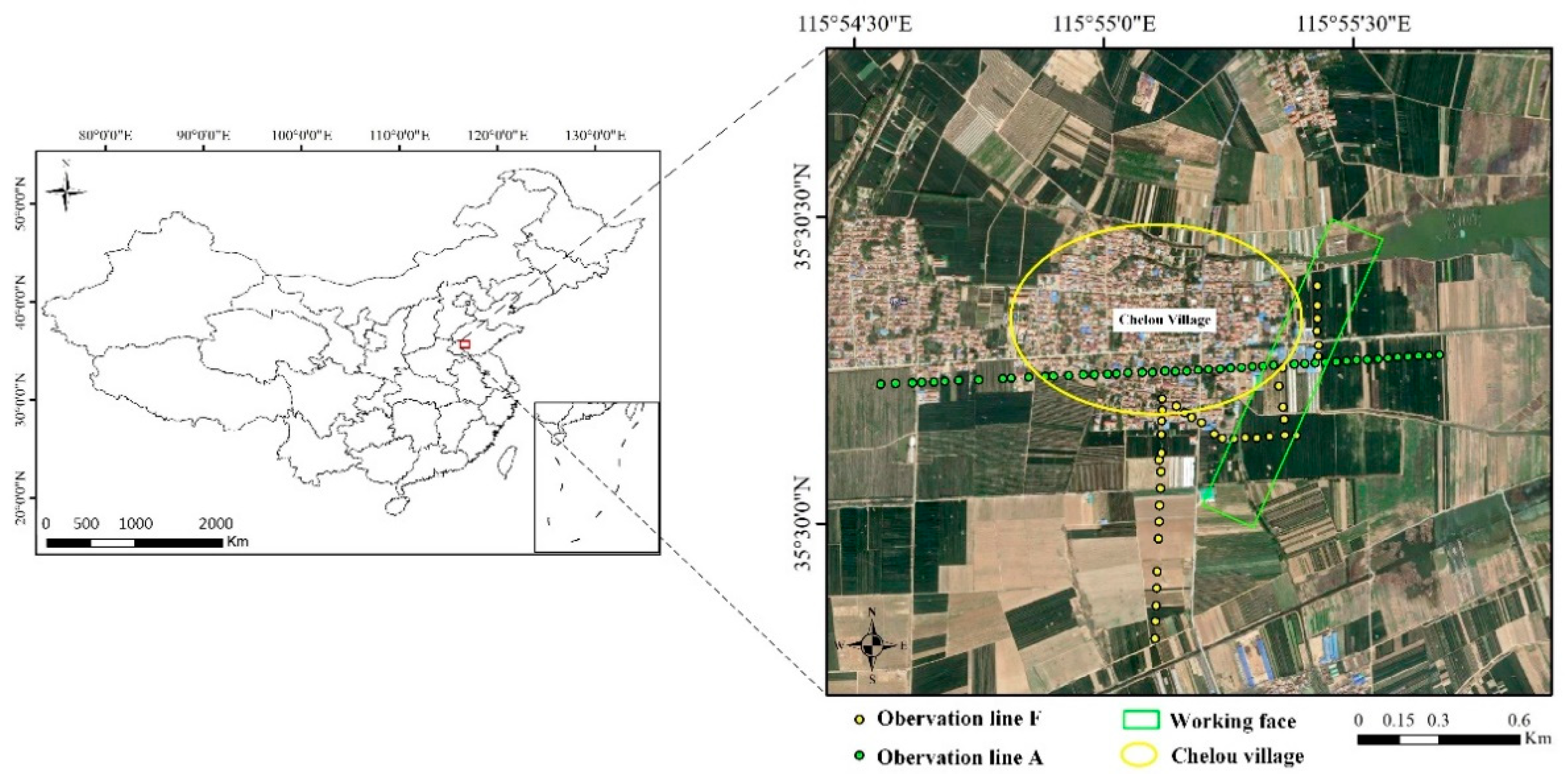
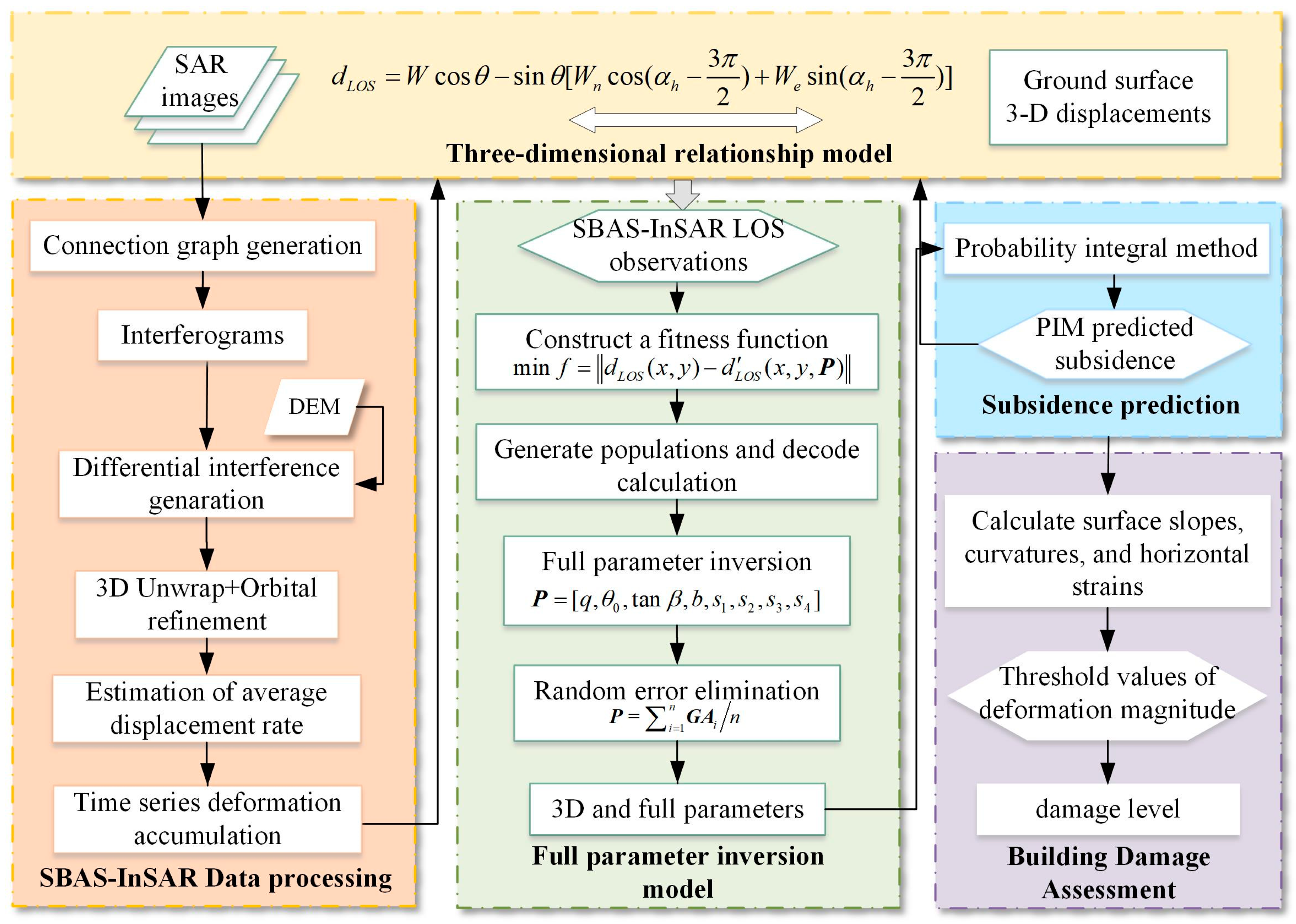
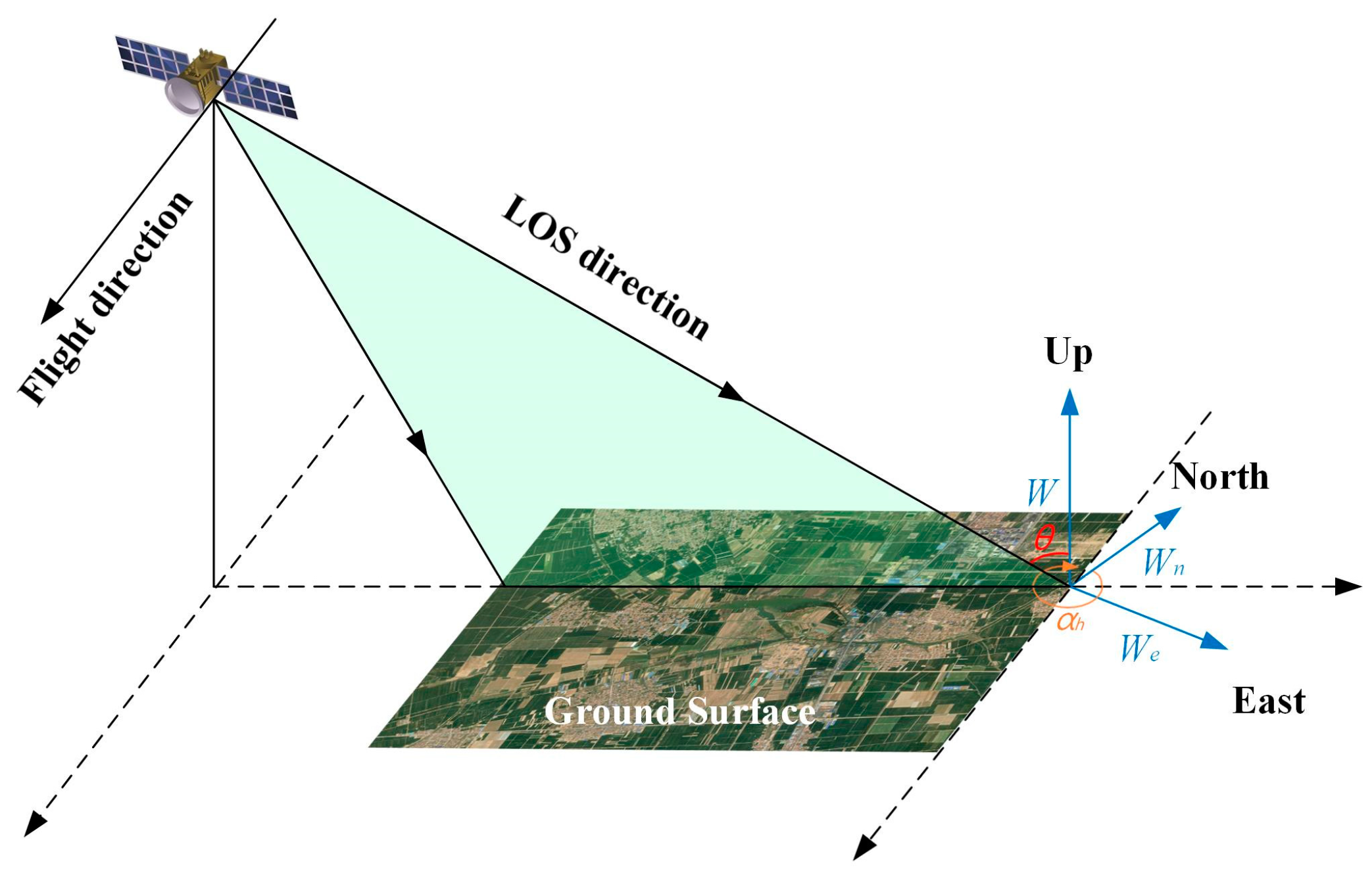

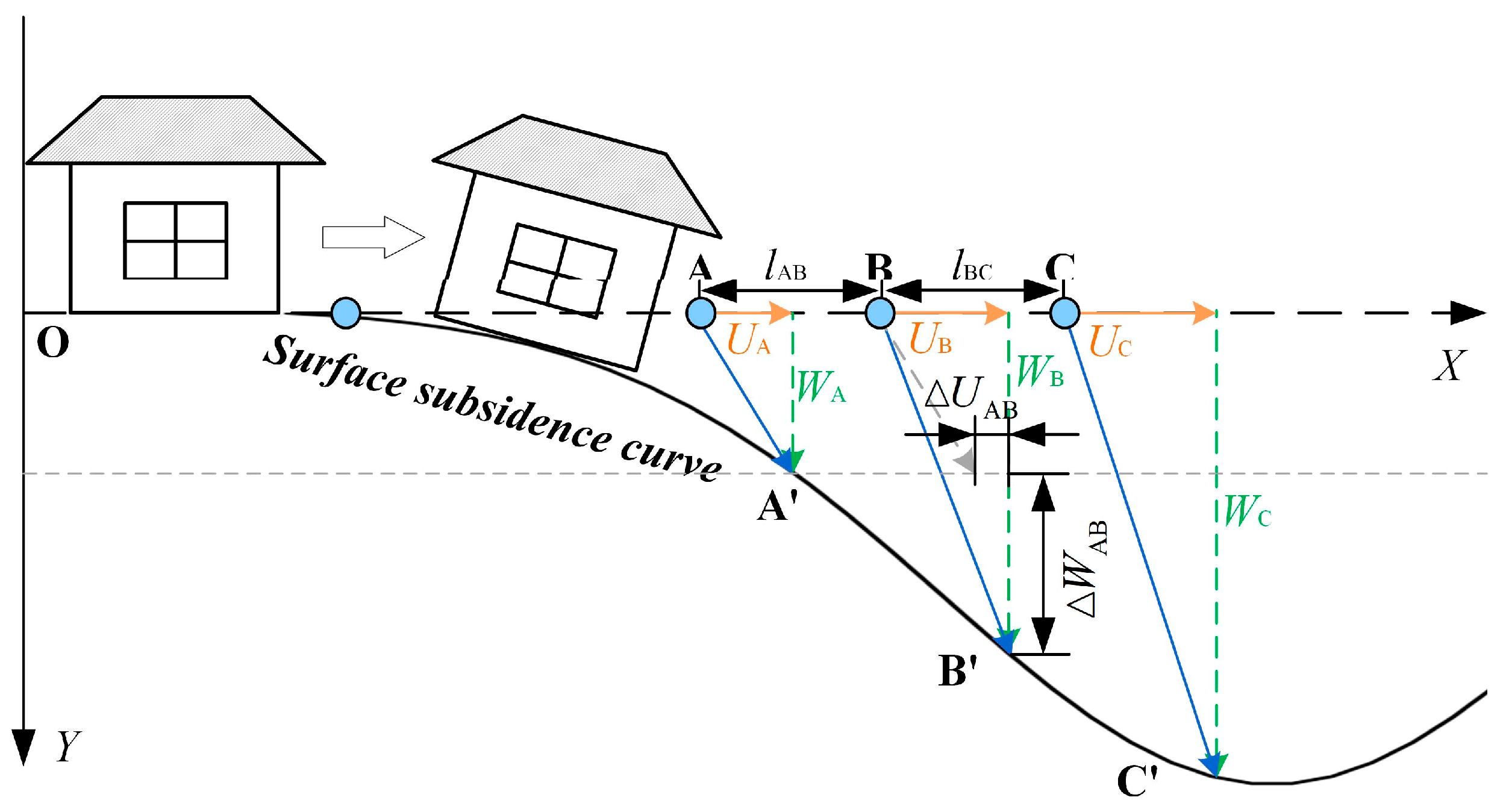

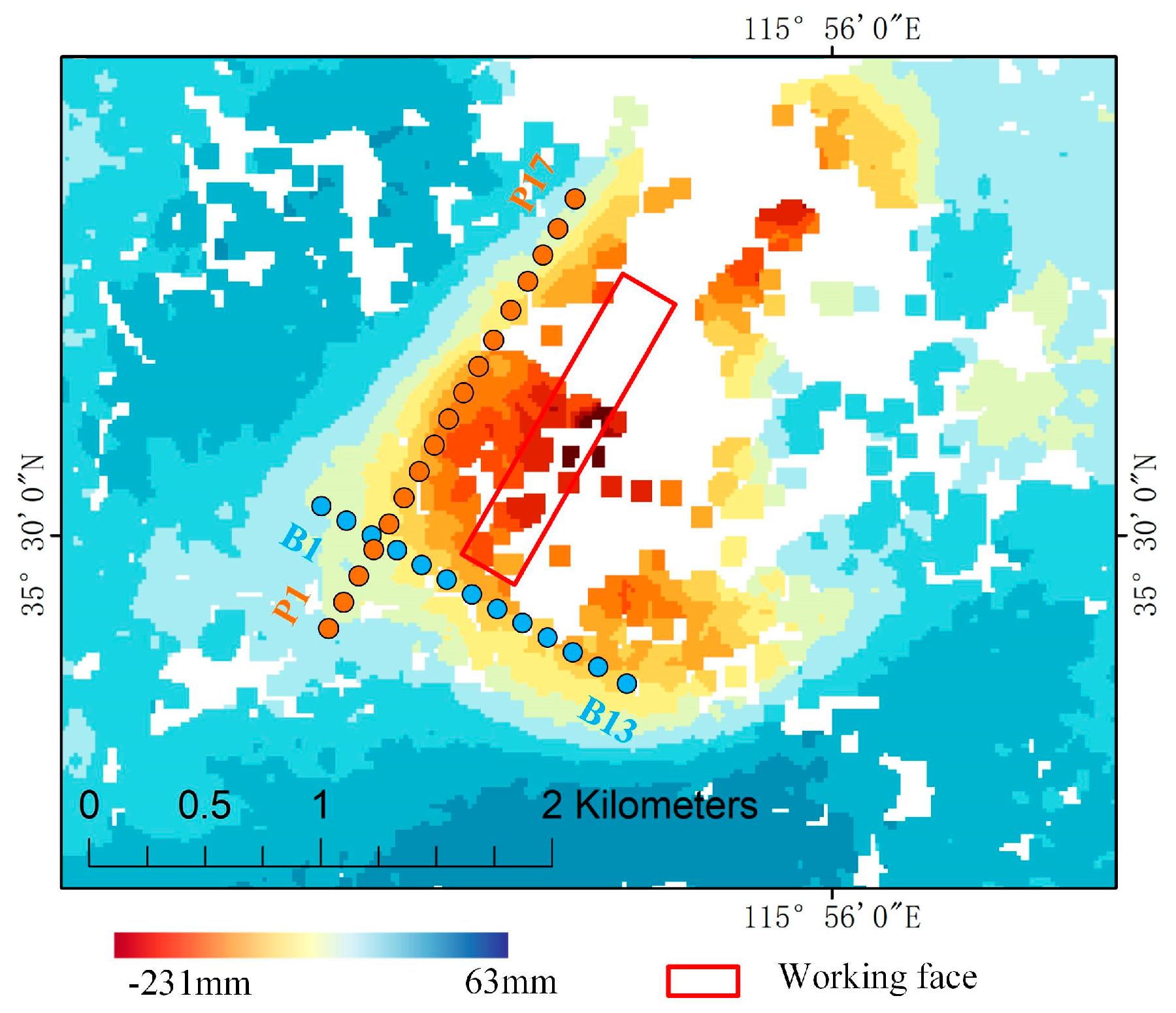
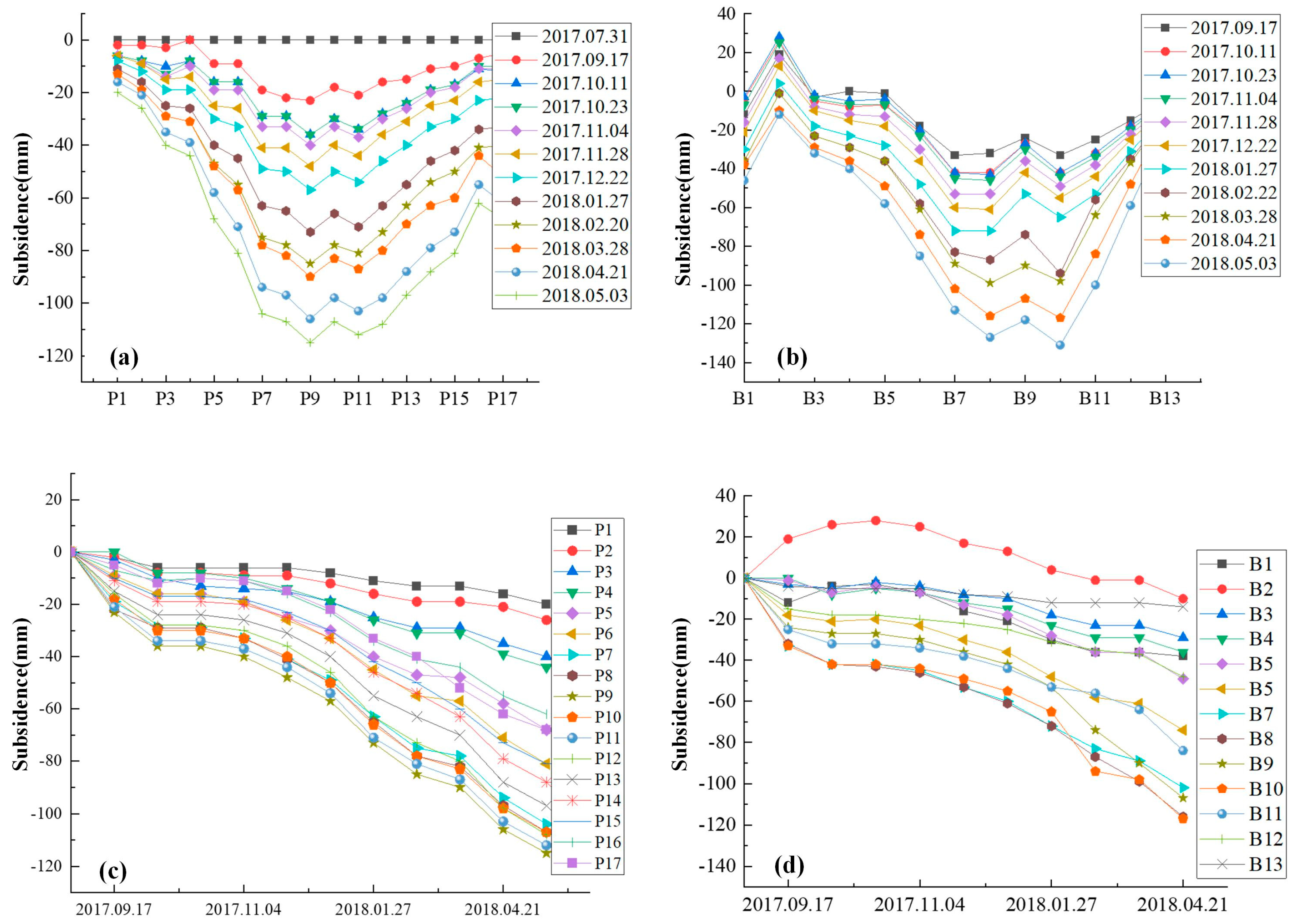

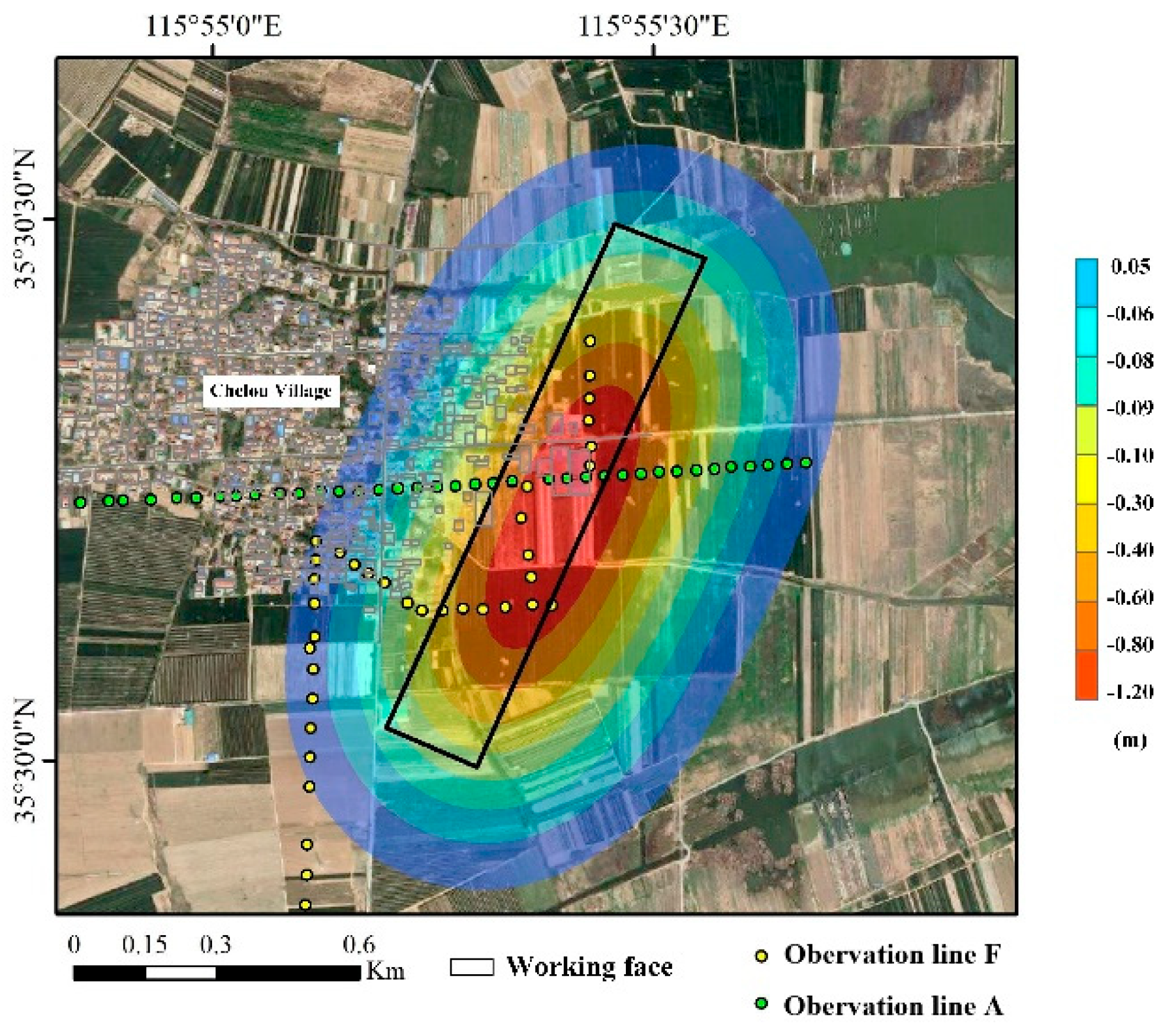
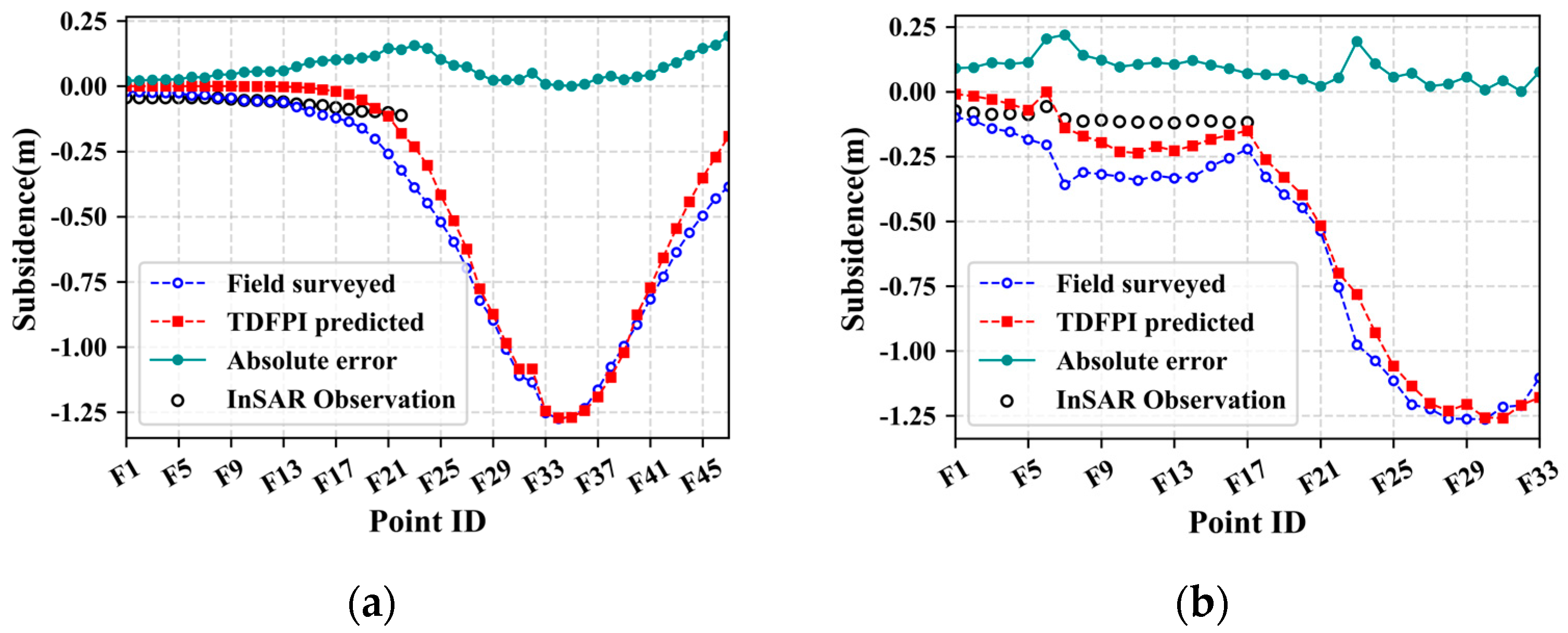
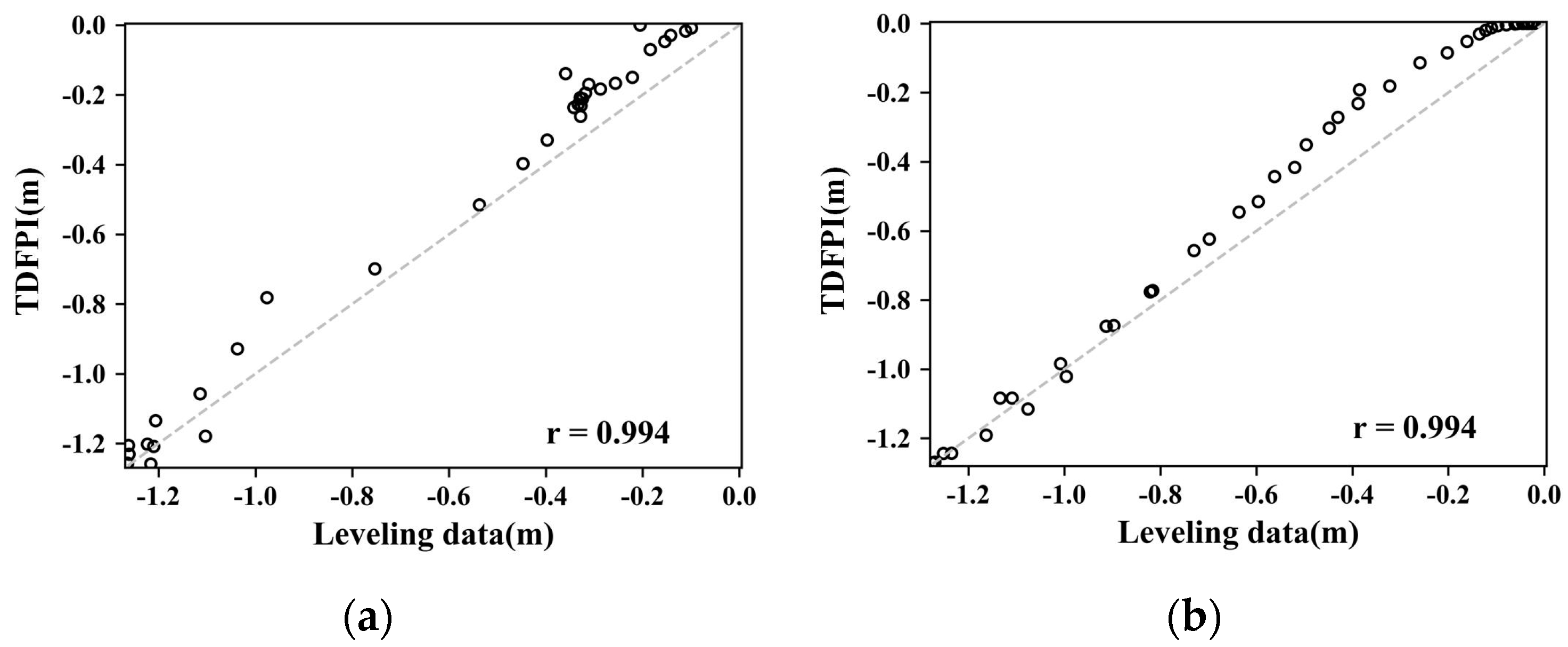



| Variables | Descriptions | Variables | Descriptions |
|---|---|---|---|
| m | coal bed thickness | main influence radius * | |
| q | subsidence coefficient | b | horizontal displacement coefficient |
| coal bed dip angle | propagation angle | ||
| vertical displacements along the strike direction | angles between the coal mine working face (strike direction) with the east and north directions | ||
| horizontal displacements along the dip direction | * | ||
| are the corresponding ground truth. | offsets in directions of the down-dip, up-dip, strike left, and strike right for the inflection points of the coal mine working face. |
| Damage Level | Possible Damage Characteristics | Deformation Magnitude | Damage Level Description | ||
|---|---|---|---|---|---|
| Surface Slope i (mm/m) | Curvature K (10−3/m) | Horizontal Strain (mm/m) | |||
| I | Small cracks less than 4 mm appear in the brick walls and ceilings. | ≤3 | ≤0.2 | ≤2 | Very slight damage with slight repairs. |
| II | The width of cracks on brick walls and ceilings grows to about 15 mm with slight damage to doors and windows. | ≤6 | ≤0.4 | ≤4 | Slight damage with minor repairs. |
| III | Cracks grow to about 30 mm with severe deformation on doors and windows. | ≤10 | ≤0.6 | ≤6 | Moderate damage with moderate repairs. |
| IV | Cracks grow larger than 30 mm and lead to serious collapse for houses. | >10 | >0.6 | >6 | Serious damage with major repairs or need to be demolished. |
| Observation Line | RMSE (m) | MAE (m) |
|---|---|---|
| Line A | 0.083 | 0.068 |
| Line F | 0.102 | 0.089 |
Disclaimer/Publisher’s Note: The statements, opinions and data contained in all publications are solely those of the individual author(s) and contributor(s) and not of MDPI and/or the editor(s). MDPI and/or the editor(s) disclaim responsibility for any injury to people or property resulting from any ideas, methods, instructions or products referred to in the content. |
© 2024 by the authors. Licensee MDPI, Basel, Switzerland. This article is an open access article distributed under the terms and conditions of the Creative Commons Attribution (CC BY) license (https://creativecommons.org/licenses/by/4.0/).
Share and Cite
Liu, H.; Yuan, M.; Li, M.; Li, B.; Chen, N.; Wang, J.; Li, X.; Wu, X. TDFPI: A Three-Dimensional and Full Parameter Inversion Model and Its Application for Building Damage Assessment in Guotun Coal Mining Areas, Shandong, China. Remote Sens. 2024, 16, 698. https://doi.org/10.3390/rs16040698
Liu H, Yuan M, Li M, Li B, Chen N, Wang J, Li X, Wu X. TDFPI: A Three-Dimensional and Full Parameter Inversion Model and Its Application for Building Damage Assessment in Guotun Coal Mining Areas, Shandong, China. Remote Sensing. 2024; 16(4):698. https://doi.org/10.3390/rs16040698
Chicago/Turabian StyleLiu, Hui, Mingze Yuan, Mei Li, Ben Li, Ning Chen, Jinzheng Wang, Xu Li, and Xiaohu Wu. 2024. "TDFPI: A Three-Dimensional and Full Parameter Inversion Model and Its Application for Building Damage Assessment in Guotun Coal Mining Areas, Shandong, China" Remote Sensing 16, no. 4: 698. https://doi.org/10.3390/rs16040698







